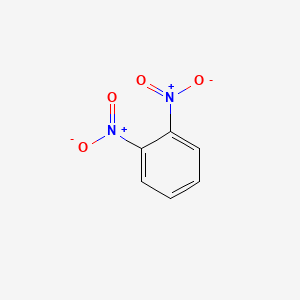



1. O-dinitrobenzene
2. Ortho-dinitrobenzene
1. 528-29-0
2. O-dinitrobenzene
3. 1,2-dinitrobenzol
4. Benzene, O-dinitro-
5. Ortho-dinitrobenzene
6. Benzene, 1,2-dinitro-
7. 1,2-dinitro-benzene
8. 25154-54-5
9. Chebi:34053
10. 35xuo924y0
11. Nsc-60682
12. Dsstox_cid_4066
13. Dsstox_rid_77278
14. Dsstox_gsid_24066
15. Dinitrobenzene, O-
16. O-dintrobenzene
17. Cas-528-29-0
18. Ccris 3091
19. Hsdb 4486
20. Einecs 208-431-8
21. Nsc 60682
22. Unii-35xuo924y0
23. Ai3-15338
24. Wln: Wnr Bnw
25. Schembl22566
26. 1,2-dinitrobenzene, 97%
27. Ghl.pd_mitscher_leg0.923
28. Bidd:er0518
29. O-dinitrobenzene [mi]
30. Chembl168075
31. 1,2-dinitrobenzene, >=99%
32. Dtxsid4024066
33. Act12765
34. Nsc60682
35. Zinc4261808
36. Tox21_201580
37. Tox21_300418
38. Mfcd00007093
39. Stl453602
40. Td1044
41. Akos000120631
42. Gs-3201
43. 1,2-dinitrobenzene, Analytical Standard
44. Ncgc00164050-01
45. Ncgc00164050-02
46. Ncgc00164050-03
47. Ncgc00254393-01
48. Ncgc00259129-01
49. O-dinitrobenzene [un1597] [poison]
50. Ac-26090
51. D0818
52. Ft-0632304
53. En300-17305
54. A20874
55. J-200033
56. Q2238767
57. Z56914842
| Molecular Weight | 168.11 g/mol |
|---|---|
| Molecular Formula | C6H4N2O4 |
| XLogP3 | 1.7 |
| Hydrogen Bond Donor Count | 0 |
| Hydrogen Bond Acceptor Count | 4 |
| Rotatable Bond Count | 0 |
| Exact Mass | 168.01710661 g/mol |
| Monoisotopic Mass | 168.01710661 g/mol |
| Topological Polar Surface Area | 91.6 Ų |
| Heavy Atom Count | 12 |
| Formal Charge | 0 |
| Complexity | 173 |
| Isotope Atom Count | 0 |
| Defined Atom Stereocenter Count | 0 |
| Undefined Atom Stereocenter Count | 0 |
| Defined Bond Stereocenter Count | 0 |
| Undefined Bond Stereocenter Count | 0 |
| Covalently Bonded Unit Count | 1 |
Readily absorbed through the skin, either as solid, liquid, or vapor. /Dinitrobenzene/
Mackison, F. W., R. S. Stricoff, and L. J. Partridge, Jr. (eds.). NIOSH/OSHA - Occupational Health Guidelines for Chemical Hazards. DHHS(NIOSH) Publication No. 81-123 (3 VOLS). Washington, DC: U.S. Government Printing Office, Jan. 1981., p. 1
Nitroreductase activity was previously known to occur under nitrogen atmosphere in the cytosolic and microsomal fractions of liver homogenates. This study describes a subcellular nitroreductase activity which occurs in liver mitochondria under aerobic conditions. Mitochondria were isolated from rat liver and assayed for their capacity to reduce certain nitro compounds by measuring spectrophotometrically both the appearance of amino compounds and the consumption of nicotinamide adenine dinucleotide. Intact mitochondria were found to possess a p-dinitrobenzene reductase activity. The activity was destroyed by heat, and was present at only 20% in the microsomal fraction. It was strictly nicotinamide adenine dinucleotide-dependent, while only little or no activity occurred with reduced nicotinamide adenine dinucleotide or other oxidative substrates. Nitro reduction was inhibited by thiol reagents. Rat liver mitochondria showed about 15% activity with o-dinitrobenzene and m-dinitrobenzene, while there was less than 5% activity with a series of p-nitro compounds including chloramphenicol.
Abou-Khalil S et al; Pharmacology (Basal) 31 (6): 301-8 (1985)
The metabolism of radiolabeled dinitrobenzene isomers was compared in hepatocytes and hepatic subcellular fractions isolated from male Fischer-344 rats. Under aerobic conditions, reduction was the major metabolic pathway for m- and p-dinitrobenzene in hepatocytes with m- and p-nitroaniline accounting for 74.0 + or - 1.2 and 81.0 + or - 0.6% (mean + or - SE, n= 4), respectively, of the radioactivity present after a 30 min incubation. The major metabolite of o-dinitrobenzene in similar incubations was S-(2-nitrophenyl)glutathione which represented 48.1 + or - 5.5% of the total radioactivity; o-nitroaniline accounted for 29.5 + or - 2.1% of the radioactivity. Incubation of dinitrobenzene with microsomes produced nitroanilines as well as nitrosonitrobenzenes and nitrophenylhydroxylamines. Reduction of o- and m-dinitrobenzene by microsomes was reduced nicotinamide adenine dinucleotide-dependent. Reduction of p-dinitrobenzene could be supported by nicotinamide adenine dinucleotide as well as reduced nicotinamide adenine dinucleotide, although the rate of reduction was slower with NADH. Conjugation of o- and p-dinitrobenzene, but not m-dinitrobenzene, with glutathione occurred in cytosol incubations although only o-dinitrobenzene formed the glutathione conjugate in intact hepatocytes.
PMID:2867868 Cossum PA, Rickert DE; Drug Metab Dispos 13 (6): 664-8 (1985)